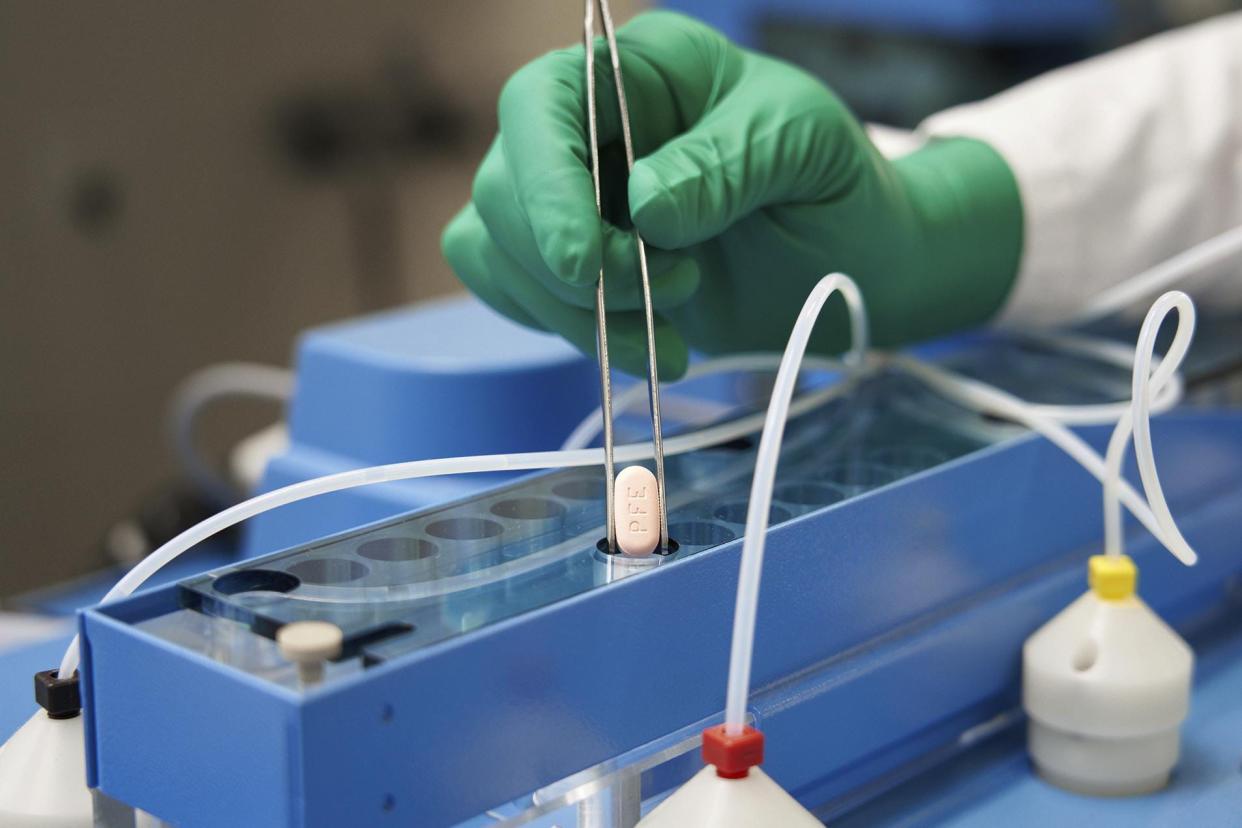President Biden is taking Paxlovid for COVID. Here's what to know about the antiviral drug

- Oops!Something went wrong.Please try again later.
- Oops!Something went wrong.Please try again later.
With a COVID-19 positivity rate of 23.37% in Jefferson County and infections from the omicron subvariant BA.5 on the rise across the nation, some are turning to the antiviral drug Paxlovid.
According to the White House, President Joe Biden, 79, is currently taking Paxlovid after testing positive for COVID-19 on Thursday.
Here's what to know about the antiviral medication:
When was Paxlovid first approved?
The U.S. Food and Drug Administration first authorized the Pfizer-backed prescription medication Paxlovid in December 2021 for emergency use.
Who can take Paxlovid?
Dr. Jason Smith, the chief medical officer at U of L Health, said system physicians have been prescribing Paxlovid in outpatient settings since its approval, particularly in patients with mild to moderate COVID-19 symptoms. He said most commercial pharmacies have Paxlovid available.
"It is still effective," Smith said. "How effective? We haven't been able to surmise against some of the new variants. But it does seem to be effective at limiting the course of the disease and the symptoms you may have."
A study from Pfizer said it reduced hospitalization and death for high risk patients by close to 90%.
The FDA says people can take Paxlovid if:
They have a confirmed case of COVID-19 with mild to moderate symptoms and have one or more risk factors that may indicate the possibility of more severe illness.
Are 12 or older and weighing at least 88 pounds.
Have no known or suspected severe hepatic or renal impairment.
Have no history of clinically significant hypersensitivity reaction.
What are the side effects of Paxlovid?
Smith said the treatment is "relatively well tolerated" with the main side effects being headaches and stomach upset.
"That's probably true for most medications you're going to take for COVID," Smith added.
In rare cases, people will experience "Paxlovid mouth," a symptom of the drug causing a bitter or metallic aftertaste. In an interview with Health, a Pfizer representative said this is a "mild" and "nonserious" symptom found to last only as long as people take the medication, which is five days.
Yale Medicine says people should consult a doctor if they experience these side effects from Paxlovid, as they indicate an allergic reaction:
Hives
Trouble swallowing or breathing
Swelling of the mouth, lips, or face
Throat tightness
Hoarseness
Skin rash
How does Paxlovid work?
Paxlovid is an antiviral medication that consists of two different oral antivirals — nirmatrelvir and ritonavir.
Maryann Amirshahi, a medical toxicologist, wrote for the National Capital Poison Center that Nirmatrelvir works to prevent the viral replication of COVID-19 while ritonavir temporarily slows the metabolism of the person taking Paxlovid. This is to keep the right levels of nirmatrelvir in the body. Together, they work to reduce the viral load of COVID-19 in the body.
Is it safe to take Paxlovid with my other medications?
It is important to tell the doctor about any medications and supplements you are taking, both prescribed and over-the-counter. Amirshahi said some may interact negatively with Paxlovid, and your doctor may modify your prescriptions to allow you to take the drug. This could mean not taking your regular prescription for a few days or taking a lower dose while on Paxlovid.
Amirshahi also added that it can cause interactions with, "medications for abnormal heart rhythm, psychiatric medications, blood thinners, gout medications, chemotherapy drugs, blood pressure medications, HIV medications, cholesterol medications, and certain herbal supplements." Antivirals have also been shown to affect hormonal birth control, so other forms of contraception may be necessary when taking the medication.
In some cases, doctors may choose to administer alternative treatments, such as an infusion of monoclonal antibodies, according to the U.S Department of Health and Human Services.
How can I get a Paxlovid prescription?
Previously, only physicians, nurse practitioners and physicians' assistants could prescribe Paxlovid. On July 6, the Food and Drug Administration expanded authorization to allow state-licensed pharmacists to prescribe it to eligible patients.
In a press release, Patrizia Cavazzoni, the director for the FDA’s Center for Drug Evaluation and Research, said: “Since Paxlovid must be taken within five days after symptoms begin, authorizing state-licensed pharmacists to prescribe Paxlovid could expand access to timely treatment for some patients..."
The FDA said when requesting Paxlovid from a pharmacist, people need to bring:
Electronic or printed health records less than 12 months old, including the most recent reports of laboratory blood work for the state-licensed pharmacist to review for kidney or liver problems. State-licensed pharmacists could also receive this information through a consult with the patient’s health care provider.
A list of all medications they are taking, including over-the-counter medications, so the state-licensed pharmacist can screen for drugs with potentially serious interactions with Paxlovid.
Reach reporter Eleanor McCrary at emccrary@gannett.com and follow her on Twitter @ellie_mccrary.
This article originally appeared on Louisville Courier Journal: What to know about COVID-19 antiviral drug Paxlovid

